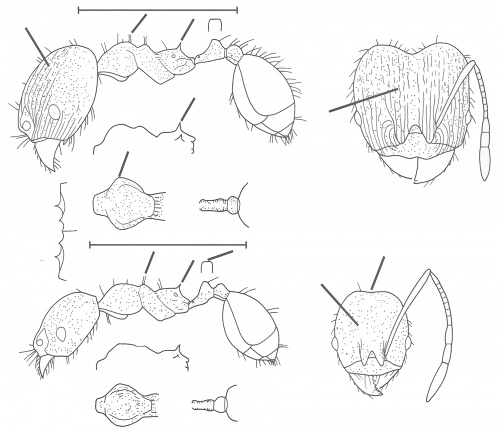Pheidole metana
| Pheidole metana | |
|---|---|
| Scientific classification | |
| Kingdom: | Animalia |
| Phylum: | Arthropoda |
| Class: | Insecta |
| Order: | Hymenoptera |
| Family: | Formicidae |
| Subfamily: | Myrmicinae |
| Tribe: | Attini |
| Genus: | Pheidole |
| Species: | P. metana |
| Binomial name | |
| Pheidole metana Wilson, 2003 | |
Winged queens were found in the Bogota-Villavicencio series on 1 May. (Wilson 2003)
Identification
See the description in the nomenclature section.
Keys including this Species
Distribution
From Wilson (2003): Known from the type locality and from the Bogota-Villavicencio Road, Cundinamarca, 1100 m, col. Charles Kugler.
Latitudinal Distribution Pattern
Latitudinal Range: 3.866667° to -0.6383°.
| North Temperate |
North Subtropical |
Tropical | South Subtropical |
South Temperate |
- Source: AntMaps
Distribution based on Regional Taxon Lists
Neotropical Region: Colombia (type locality), Ecuador.
Distribution based on AntMaps
Distribution based on AntWeb specimens
Check data from AntWeb
Countries Occupied
| Number of countries occupied by this species based on AntWiki Regional Taxon Lists. In general, fewer countries occupied indicates a narrower range, while more countries indicates a more widespread species. |

|
Estimated Abundance
| Relative abundance based on number of AntMaps records per species (this species within the purple bar). Fewer records (to the left) indicates a less abundant/encountered species while more records (to the right) indicates more abundant/encountered species. |

|
Biology
Castes
Nomenclature
The following information is derived from Barry Bolton's Online Catalogue of the Ants of the World.
- metana. Pheidole metana Wilson, 2003: 617, figs. (s.w.) COLOMBIA.
Unless otherwise noted the text for the remainder of this section is reported from the publication that includes the original description.
Description
DIAGNOSIS Major and minor: pilosity of mesosomal dorsum short, erect, and consisting mostly of pairs (see also Pheidole angusticeps and Pheidole meinerti).
Major: dorsum of head covered to occipital margin by longitudinal carinulae, which are faint and broken in the posterior half; rest of sculpturing consists solely offoveolation, covering all of the body except the gaster, which is entirely smooth and shiny.
Minor: all of head and me so soma foveolate and opaque; sculpturing otherwise entirely absent except for carinulae on margins of the frontal lobes; head narrowed posteriorly, but nuchal collar absent.
MEASUREMENTS (mm) Holotype major: HW 0.80, HL 0.80, SL 0.60, EL 0.12, PW 0.40. Paratype minor: HW 0.44, HL 0.52, SL 0.60, EL 0.08, PW 0.28.
COLOR Major and minor: concolorous medium yellow.
Figure. Upper: holotype, major. Lower: paratype, minor. Scale bars = 1 mm.
Type Material
COLOMBIA: Transecto Sumapaz, Meta, 920 m, col. T. van der Hammen. Museum of Comparative Zoology
Etymology
Named after the department of Colombia from which the type series originated.
References
- Wilson, E. O. 2003. Pheidole in the New World: A dominant, hyperdiverse ant genus. Harvard University Press, Cambridge, MA. (page 617, fig. major, minor described)
References based on Global Ant Biodiversity Informatics
- Mertl, A.L. and J.F.A. Traniello. 2009. Behavioral evolution in the major worker subcaste of twig-nesting Pheidole (Hymenoptera: Formicidae): does morphological specialization influence task plasticity? Behavioral Ecology and Sociobiology 63:1141-1426
